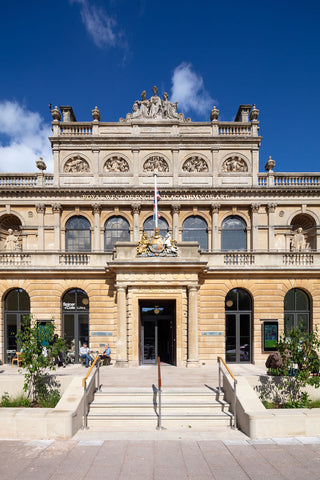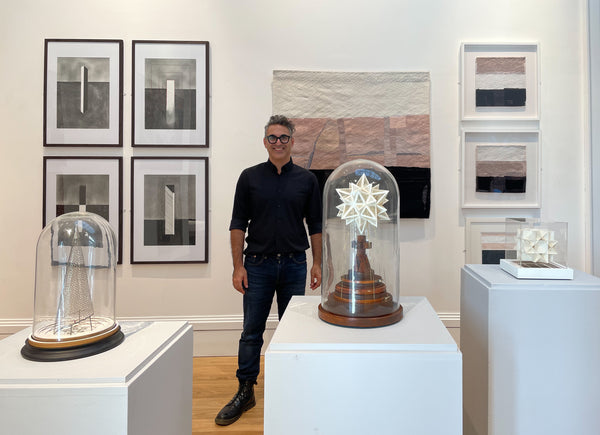Q&A with our new Academicians: Ian Chamberlain and Karl Singporewala

At the start of this year, we welcomed two more Academicians to the RWA. We caught up with them and found out what made them apply for Academician status and their ambitions for the year ahead.
Ian Chamberlain RWA

-
What made you apply for RWA Academician status?
-
What does becoming an RWA Academician mean to you?
Becoming an RWA academician makes me feel very proud that current Academicians I respect and admire have given me the support and encouragement to be part of the RWA Academic institution. It gives me an opportunity meet new people and formulate new relationships and being part of a wider community.
-
Can you describe your practice and let us know any sources of inspiration?
My practice has always had an emphasis on architectural forms, reinterpreting manmade structures as monuments placed within the landscape, acting as architectural metaphors of past and current technological achievements.
I have had a longstanding fascination with technology and architecture, these have included structures within industry, agriculture, science and the military.
Past locations I have documented include The Goonhilly Earth station, The Lovell Telescope, The Maunsell Sea Forts and the Acoustic Sound mirrors.
I am interested in the use of a traditional Print process such as etching being used to record subject matter that is generally at the cutting edge of technology for its time.
The etchings become an extension of his drawing allowing me to record the location through the interlinking processes of drawing and printmaking.
My most comprehensive body of work to date deals with ‘The Atlantic wall’. The Atlantic Wall was a system of coastal fortifications built by Nazi Germany 1942 - 1944 along the western coast of Europe stretching over 6000 miles. The Atlantic Wall was both a practical line of defence and a propaganda tool. I have reinterpreted these brutalist forms as architectural metaphors, architectural reminders of a shifting political, social and environmental landscape.
During the lockdown period my latest work has started to expand into new creative fields, exploring ideas around shelters, frontiers and boundaries.
I am recording a range of architectural with a multi-disciplinary approach including Drawing, Printmaking, photography and soundscapes. The work is underpinned through the use of drawing and translated through a range of traditional and contemporary processes.
-
What are your highlights of 2022 and ambitions for 2023?
- Invited to be in an International exhibition – The Point of truth Beauty and Knowledge, Dortmund, Germany.
- Selected for the exhibition ‘ A Century in print” Chippenham Museum and work purchased for the permanent collection.
- Selected and shortlisted for the Trinity Buoy Wharf Drawing Prize, 2022
- Presenting my paper Synthetic Landscape –IMPACT 12 International Print conference.
- Receiving the RWA Drawing Award
- Selected to become an RWA Academician.
Ambitions for 2023
As well as my full time teaching commitments at UWE, Bristol and integrating myself into the RWA community I have two mains areas of focus for the upcoming year.
- I am looking forward to working with the International emergency relief charity ‘ ShelterBox ’. An event is being planned for late Autumn this year in London. The event will involve an exhibition and presentation to the charities sponsors and Donors. The work focuses on our basic need for shelter and protection. I have been recording a range of structures using drawing and Print to highlight and layer repeating shapes and forms. Some of these forms are abstracted and layered in a state of flux and change.The aim is that my body work focusing on Shelter acts as a vehicle to reach wider audiences for not only my practice but to promote the humanitarian work of ShelterBox.
- I am also planning to start researching a new body of work at ‘ Orfordness ‘ A former cold war military site in Suffolk. The site has been used as secure location for to develop technologies in the fields of photography, radar and trigger systems for Britain’s nuclear armoury. It is a very strange, open and quite location with a wide range of abandoned brutalist structures scattered along the shingle spit. I am hoping that the location will act as an immediate reference but also a catalyst to contemplate develop new ideas.
The short story Terminal beach by JG Ballard is a major source of inspiration for this new work.I look forward to sharing these experiences with you.
Karl Singporewala ARB RIBA RWA

-
What does becoming an RWA Academician mean to you?
The annual open exhibition system is unique among most professions in the world. Where else can a ‘starter’ be placed on equal footing with a ‘master’? This camaraderie and competition equals mentorship, and it has helped define my career to date. For example, my first post-graduate architecture job came as a direct result of being selected for my first ever open exhibition. I met the academician selector, thanked them for selecting my work, got offered a job, and ended up enjoying ten wonderful years of collaboration!
The RWA has been a great bedrock in nurturing my creative output, by providing me with the opportunity and a platform to exhibit my work for over a decade. The RWA represents a unique institution where fine art and architecture can co-exist as part of the main discourse; this has been particularly pertinent for me as a practising architect.
My career has been fostered by the core values of the academy, and becoming a RWA Academician, represents a lifetime of collaborate, opportunity, education and interaction. I’m honoured.
-
Can you describe your practice and let us know any sources of inspiration?
My artwork is a manifestation born out of the limitations of my profession. Architects rarely ‘build’ their own buildings, as they are ultimately constructed by others. The only thing they can truly compose and command are their drawings and models. At an elemental level, my work represents raw ideas, themes and feelings; all manifested spatially. Sometimes they are eloquent, considered and laboured… but other times they can be illiterate, sketchy, or even lonely.
If I was a writer or a poet I’d write about my feelings. If I was a musician, I would sing about them. I am a designer, so for example, when I want to commemorate the death of the Parsi community due to its reluctance to shed a thousand-year-old rule on hereditary membership, I design a memorial called The Last Tower of Silence. There is no commission here, no audience, no archi-babble, just a manifestation of something internal that I don’t know how to communicate in any other way. They are usually internal issues which I struggle to describe in words, like I said, if I could put it into words, I would have been a writer!
-
What are your highlights of 2022 and ambitions for 2023?
Being elected as an RWA academician was the perfect end to 2022. It followed two separate building awards by publication Architecture Today (in association with manufacturer Schueco), as well as hearing that a historic project I had been involved with at ritchie*studio won a World Architecture Festival special prize.
2023 is already off to a flying start where I have been recently appointed as a director at LTS Architects. The opportunity to help lead, design and deliver buildings at such a well-considered contemporary design studio is a real treat for me. Our goals place sustainable outcomes and the simple desire to make a better built environment at the heart of everything we collectively design.
In terms of specific RWA ambitions - Bristol, Bath and surrounding region have a rich history of architecture and engineering. This aspect could be further enhanced with more links between architecture practices, institutes and universities in the city and wider region. Therefore, I see real opportunity to help grow a significant architecture programme at the RWA, a programme which compliments and enhances all that is already on offer. This is my long-term ambition for the academy, we can plant the seeds in 2023.